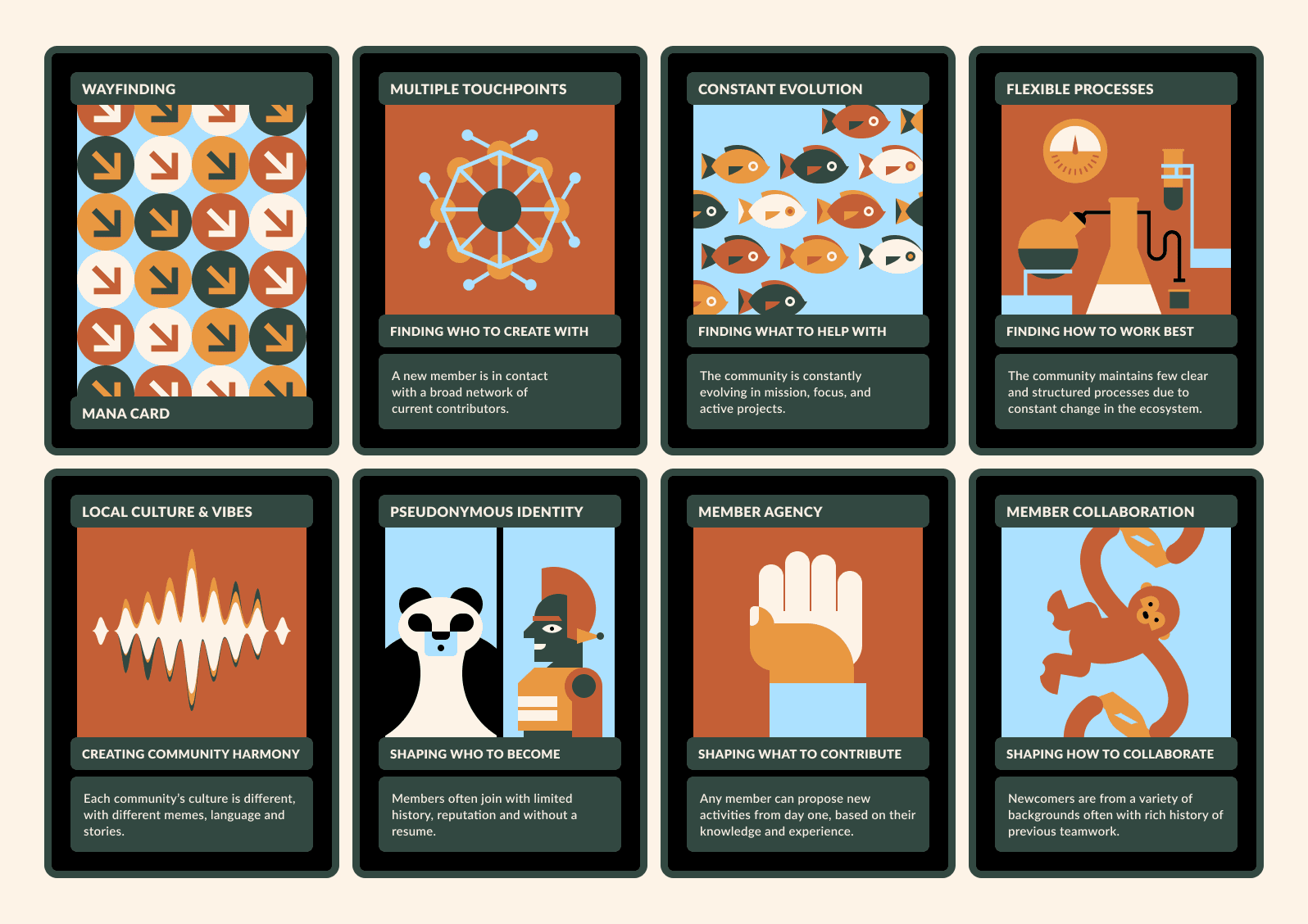Welcome to the second deep dive on how we are building CabinDAO. In this article we'll cover how onboarding differs from traditional corporate environments. Then we'll break down current onboarding practices and offer digital-native ideas. Finally, we’ll share how a few leading DAOs, including Cabin, are building their new member journeys.
New member journeys in digital communities
At around 11am on Saturday, Alice logged into Discord and joined the new server… A new adventure began. She hopped through the portal, down the rabbit hole, and into the warm vibes of a bustling new community. At 11:05am collab.land confirmed her wallet and dozens of channels emerged, sprouting like springtime daffodils. And at that point - excitement turned into anxiety. It was too much, too soon. Where should she go next? How should she get involved?
Many of us have felt like Alice throughout the last few months. We were focused and ready to build at first, but information overload, overstimulation, and lack of clear contribution pathways dissipated our attention. Onboarding to DAOs feels like doing improv without a coach or playing jazz for the first time. It’s challenging to fall into rhythm with new communities.
How can we capture this opportunity? How can we create an experience where new members can find their way easily and seamlessly as they join the community?
A new paradigm for onboarding is needed. Digital-native organizations are not SaaS companies that need to onboard customers or employees. If the end goal for company onboarding is a paying customer or a happy employee, the end metric of digital wayfinding is helping the new member understand how contributors make their first community contribution.
In this way, we can create a continuous welcoming experience in multi-dimensional spaces, with members co-creating the adventure.
What’s changed? Dynamic Spaces.
In traditional organizations like SaaS tech companies, most onboarding focuses on a unidirectional conversations. The company prepares new employees to execute a pre-defined role or trains new customers to use a product effectively. Although there are exceptions, the organization mostly directs the agent.
In DAOs, this dynamic is a 2-way street: a new member learns to navigate the community, and the community learns how to integrate the member into the mission. Multiple time-zones, constantly changing priorities, and a highly volatile ecosystem complicate this further.

💡 Read more about legitimate participation in complex environments.
A new perspective for onboarding: Wayfinding
At the end of the day, we noticed that onboarding for digital communities is like joining a new group game or hiking a new trail. Dug, one of our members, coined a new concept that covers this paradigm: wayfinding.
Wayfinding is “the process or activity of ascertaining one's position and planning and following a route.” When we think about onboarding as wayfinding, we reframe our design. Instead of just focusing on sharing knowledge and instructions, we include new concepts related to navigation, activation, and learning.
Onboarding Design: Questions and Inventories
To better design our onboarding process, we first listed questions using wayfinding language and then created an inventory of current and potential onboarding practices.
Part 1: Asking Questions
- What signs do we use at an individual, community, and ecosystem level? Are they easily understood by newcomers?
- How does the community learn about new members, instead of putting the focus solely on the member learning about the community?
- What introductory paths (e.g. visitor routes) are available within the org? What other paths and journeys should the community create?
- How do we identify “lost” members and nudge them in the right direction?
- How do we encourage new members to shape their own paths?
Of course, many more questions may come up. Make sure to explore new member navigation, contributor activation, and learning.
Part 2: Creating an Inventory
Documenting an inventory of current and potential practices proved useful. It highlighted inconsistencies and gaps, and gave us new ideas.
Each practice was mapped to a specific web3 challenges, and then grouped in three categories related to wayfinding: (1) Finding, (2) Harmonizing, and (3) Shaping.
- FINDING: Onboarding processes related to new member questions about the current community people, model, and process.
- HARMONIZING: Onboarding practices about tuning into the right mindset, culture, and language.
- SHAPING: Onboarding practices related to how new members should bring their own perspective and knowledge to innovate in the community.


💡 Click here to access the table
Learning from the DAO community
Although we’re still in early days of community design, there’s a lot we can learn from each other. Here we’ve highlighted a few experiences that can serve as inspiration for others:
Bankless DAO: Portals, Gates, and Information Access
Friends with Benefits: Digital Maps
Forefront: Contribution Zones
IndexCoop: Community Handbook
Superteam DAO: Status, Clarity, Progression
KrauseHause: Personal Greetings and Surveys
"At Krause House, we are striving to create an onboarding experience for each new member archetype. Whether someone joins with the intent to contribute, lurk, or guild up, we try to make sure they can get up and running as quickly as possible. In addition, we try to engage each new member with a personal greeting and basketball related question as a warm welcome."
What’s next for Cabin?
During our next season we will be experimenting with changes to our onboarding process. Specifically, we will be designing our Discord channels like a town, encouraging members to include time-zones in their names, and creating dedicated channels for active bounties.
If you’d like to get involved and help us build the future of digital cities, swing by the Discord and say hello. Looking forward to seeing you there!
APPENDIX: Recommended Reading
- More Onboarding Tips (1) (Tweet)
- More Onboarding Tips (2) (Tweet)
- Wayfinding (Wikipedia)
- Situated Learning, Legitimate Peripheral Participation (Wikipedia)
- Cynefin Framework (Wikipedia)
- The Situationalists: Derive (Essay)
- A Pattern Language (Book)
- The Great Good Place (Book)